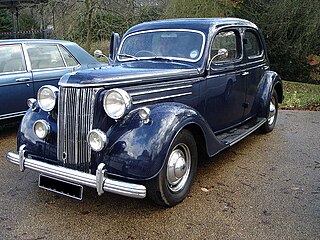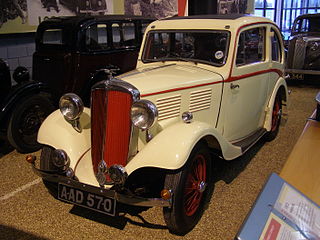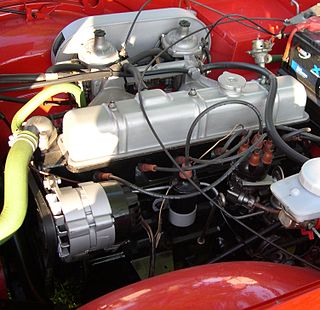
The Ford Pilot Model E71A is a medium-sized car that was built by Ford UK from August 1947 to 1951. It was effectively replaced in 1951 with the launch of Ford UK's Zephyr Six and Consul models, though V8 Pilots were still offered for sale, being gradually withdrawn during that year. In its production run 22,155 cars were made.

The Triumph Super 7 is a car manufactured from 1927 until 1934 by the Triumph Motor Company. It was produced as a response to the success of the Austin 7 and was Triumph's first car to be made in large numbers. In 1933 the name was changed to the Triumph Super 8.

The Triumph TR range of cars was built between 1953 and 1981 by the Triumph Motor Company in the United Kingdom. Changes from the TR2 to the TR6 were mostly evolutionary, with a change from a live axle to independent rear suspension in 1965 and a change from a four-cylinder engine to a six-cylinder engine in 1967. An all-new TR7, with a unit body, an overhead camshaft four-cylinder engine, and a live rear axle, was introduced in late 1974. The TR8, a development of the TR7 with a Rover V8 engine, was introduced in 1979 and was sold alongside the TR7 until TR production ended.

The Triumph Roadster is a roadster produced by Britain's Standard Motor Company from 1946 until 1949. It was first available as the Triumph 1800 Roadster (18TR) from 1946 to 1948 and then as the Triumph 2000 Roadster (TRA) from 1948 to 1949.

The Standard Vanguard is a car which was produced by the Standard Motor Company in Coventry, England, from 1947 until 1963.

The Triumph Dolomite is a car that was produced by Triumph Motor Company from 1934 to 1940. It first appeared in 1934 as a sports car and the name was also used from 1937 on a series of sporting saloons and open cars until 1939 when the company went into receivership. A number were still sold and registered in 1940, though it is uncertain whether the receiver or new owner turned out cars from spare parts, or sold off completed cars. All except the Straight 8 featured a "waterfall" grille styled by Walter Belgrove, versions of the saloons with conventional grilles were sold as Continental models.

The Jowett Bradford was a British light van produced from 1946 to 1953 by Jowett Cars Ltd of Idle, near Bradford, England. It was also available as an estate car from 1947 to 1953.

The Standard Eight is a small car produced by the British Standard Motor Company from 1938 to 1959.
The Triumph 20TS was a prototype sports car shown by Standard-Triumph in October 1952 at the London Motor Show. Extensive development of the 20TS led to the introduction of the Triumph TR2 in March 1953 at the Geneva Motor Show, after which the 20TS was unofficially referred to as the Triumph TR1. Only one example of this car was ever made by Triumph.

The Standard Ten was a model name given to several small cars produced by the British Standard Motor Company between 1906 and 1961. The name was a reference to the car's fiscal horsepower or tax horsepower, a function of the surface area of the pistons. This system quickly became obsolete as an estimate of the power produced by the engine, but it continued to be relevant as a way to classify cars for tax purposes. Like other manufacturers, Standard continued to use the name to define the approximate size of their 'Ten' model long after the origins of the name had, in Britain, become inapplicable.

The Vauxhall Wyvern is a medium-sized family car introduced by Vauxhall in 1948 as a successor to the Vauxhall 12. The name comes from the mythical beast the wyvern, and may be due to a misidentification of the heraldic griffin on the Vauxhall badge.

The AC 2-Litre is an automobile that was produced by AC of Thames Ditton in Surrey, England between 1947 and 1956. Two and, from 1952, four-door saloons were sold. In addition, as from 1949, a small number of drophead coupés and "Buckland" tourers were produced.

The Alvis Three LitreTA 21, is an automobile which was produced by Alvis Cars between 1950 and 1953. It was announced to the British public the day it went on display at the opening of the Geneva Motor Show 16 March 1950.

The Triumph Renown is strictly the name given to the Triumph's large saloon car made from 1949 to 1954 but it is, in reality, part of a three-car series of the 1800, 2000 and Renown models. Together with the Triumph Roadster, they were the first vehicles to carry the Triumph badge following the company's takeover by the Standard Motor Company.

The Alvis Fourteen also known as TA 14 was the first car to be produced by major defence contractor Alvis cars after World War II. The entire car factory had been destroyed on the night of Thursday 14 November 1940. Announced in November 1946 it was made until 1950 when its postwar austerity 1900 cc engine was replaced by the 2993 cc 26.25 HP Alvis Three Litre or TA 21.

The Armstrong Siddeley Lancaster is an automobile which was produced by Armstrong Siddeley Motors Limited from 1945 until 1952. It was the first post-war sports saloon to be made by the company.

The Armstrong Siddeley Hurricane is a two-door, four-seat drophead coupé automobile produced by the British company of Armstrong Siddeley from 1946 until 1953. It was based on the Armstrong Siddeley Lancaster saloon.

The Triumph Six Cylinder or Triumph I6 engine is a cast-iron overhead valve straight-six engine produced by Standard Triumph. It is an evolution of the Standard Motor Company's inline-4 Standard Eight, with the addition of two cylinders and a larger displacement.

The Standard wet liner inline-four engine was an inline four cylinder petrol engine produced by the Standard Motor Company. Originally developed concurrently for passenger car use and for the Ferguson TE20 tractor, it was widely used for Standard passenger cars of the 1950s, most notably the Vanguard. Later it was successfully used in Standard's popular early generation Triumph TR series sports cars.

Morris Oxford Series MO is an automobile produced by Morris Motors of the United Kingdom from 1948 to 1954. It was one of several models to carry the Morris Oxford name between 1913 and 1971.





















